Loudspeakers
Introduction
Since audio designers are forced to choose a lot also on a subjective basis, I think there is no "right" or "wrong" way of designing loudspeakers. The quality of a design depends on how seamless every single aspect has been integrated. It also seems to be at least partly a matter of taste.
Type of Loudspeaker
This is probably the most delicate and difficult part of the design process.
- Driver type?
- Full range, two way, three way or even n-way?
- Dipole, sealed, vented, transmission line, TQWP or horn?
I have found very good sounding commercial loudspeakers of almost any type you can imagine. Moreover, I owned, designed and built sealed, Onken vented, transmission line, fullrange, 2 to 4-way, electrostatic and magnetostatic loudspeaker systems. All of them had strengths and weaknesses.
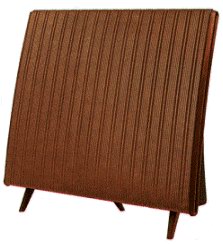
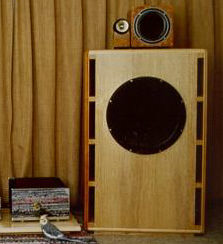
Quad ESL 57 & DIY Onken-Mahul System
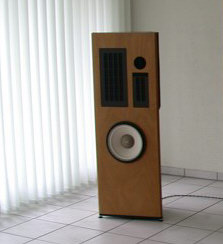
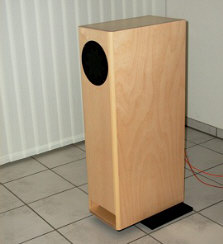
DIY Fostex Magnetostats & DIY Manger TML System
Working on my last speaker project which has been a three chambered, fullrange TML speaker with Manger's Bending Wave Transducer MSW, I came to the conclusion that there is not really an enclosure topology which fulfills all my idealised requirements. What now?
Design Considerations
As mentioned above, there is no topology which is superior in all aspects. Nevertheless, In my opinion I have selected some important items which can - well-balanced used and adapted to the driver - lead to an excellent result more or less independent of the overall enclosure topology:
A room friendly frequency/sound pressure response
- Smooth frequency response from about 40 Hz to 16 kHz in the only environment which really matters - your listening room!
- Minimal excitation of room resonances
- Compensation of baffle diffraction loss
Listening fatigue-free drivers
- Good step and impulse response
- Low amounts of stored energy in the driver
- Low distortion, especially the third harmonic
No enclosure - but at least one you (almost) do not hear
- Low amounts of stored energy in the cabinet
- Minimal enclosure sound radiation along with the driver
- Restricted use of ordinary (and non-linear) damping materials which can lead to a loss of micro information of radiated sound from the driver
And last but not least
- It is wise to keep the design "simple, stupid", which means effective and minimal use of discrete components!
Listener Friendly Sound Pressure Response
One issue is the room acoustics. As shown in the part "Listening Room Analysis", we should be able to get huge gains from the room in the range from 20 to 80 Hz. In reality the gains are a little bit less, because of flexible room boundaries, open doors etc. Still, even a 9 to 10 dB gain improves the acoustical energy in the room very much. Not too bad and it's free!
Another issue is the baffle diffraction loss. At high frequencies, a loudspeaker radiates sound directly forwards. At low frequencies, the sound "leaks" around the sides and rear of the enclosure, and becomes omnidirectional. This transition leads to a loss of sound pressure on the forward axis at low frequencies, and measured in an anechoic chamber the loss is between 4 to 6 dB.
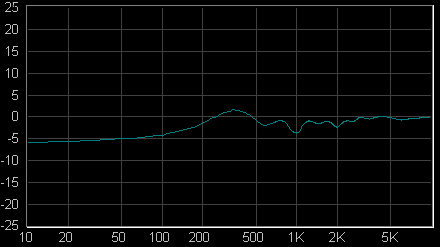
Example of a baffle diffraction loss frequency response after Olson
The center frequency of the transition and amount of loss is dependent on the dimension of the baffle. The smaller the baffle the higher the transition frequency and the higher the loss. The magnitude of oscillations along the frequency response can be reduced by several measures such as using felt blocks around the driver, by having different distances from the driver to each edge and/or by rounding off the cabinet edges.
Once a normalised room sound pressure response and the diffraction loss are known it is possible to design an idealised loudspeaker sound pressure response that will exactly mirror these two combined responses.
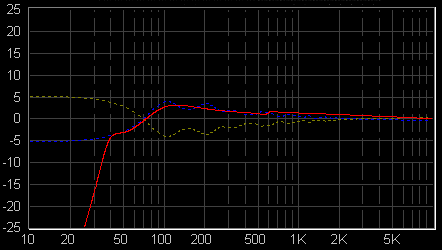
brown dashed line = Combined response of normalised room sound pressure
response and baffle diffraction loss for a baffle between 25 to 30 cm
blue dashed line = Mirrored sound pressure response as basis for loudspeaker design
red line = Example of an adapted 2 Pi loudspeaker frequency response
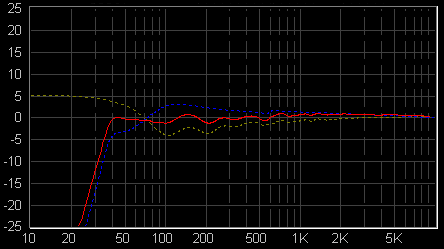
brown dashed line = Combined response of normalised room sound pressure
response and baffle diffraction loss for a baffle between 25 to 30 cm
blue dashed line = Example of an adapted 2 Pi loudspeaker frequency response
red line = Resulting in room sound pressure response
While the reference sound pressure response adjusts the substantial room-gain and baffle diffraction loss, the room modes and resonances have not been eliminated! However, you will be surprised to which degree the so-far prominent and irregular bass has been eliminated too (the ear seems to be very tolerant to room modes as long as the overall balance of sound pressure is guaranted).
Listening Fatigue-Free Driver
I love the transparency, sonic detail, clarity and impulse behaviour of electrostatics and also magnetostats. Furthermore, I was very attracted by the Heil Air Motion Transducer as well as some paper/carbon composite and ceramic drivers. Ok, there is a lot of choice!
Then, I listened to Manger's Zerobox. This loudspeaker comes close to an electrostatic, but there was no breathtaking clarity or impulse reproduction. There was just this holographic sound reproduction, I have never heard before. So, I listened a few hours to these speakers with a great variety of material, studied their technical basis and in the end I decided to use the Mangers for a new design.
So then, what is my "listening fatigue" -free driver? After the event I would say: At the least, it is a speaker which has a good impulse behaviour without transient errors. This can be proved by the impulse and step response.
And what is your preferred "listening fatigue" -free driver or speaker?
Influences of Enclosures on Sound
Enclosures have three major influences on sound quality:
Firstly, they have an important effect on the driver response in the bass region due to the topology, such as sealed or vented designs etc. , and of course, its baffle diffraction loss.
Secondly, they radiate sound along with the driver: On the one hand when a driver is mounted in an enclosure it radiates as much energy into the space in front of the driver as it does into the enclosure behind the driver. The energy behind the driver leads to a pressure inside the enclosure. Some of the energy is lost as heat in regular damping materials, some in flexing the enclosure walls. Much of it reappears outside the enclosure, because of the thin speaker cone which usually presents a very weak sound barrier. On the other hand a driver directly transmits mechanical vibrations to the enclosure. I am convinced that these effects are most notable in the bass and upper bass region, where regular damping materials are considerably ineffective. All these effects are important and I am also convinced that many people have very little idea of the incredible amount of sound, across a broad frequency range, that can come right through the walls of a speaker cabinet as well as the driver cone.
Thirdly, regular stuffing and damping materials are, as mentioned above, not only ineffective in the bass region but also have a non-linear behaviour over the entire range of frequency and different sound power levels (SPL). This non-linearity influences the cone movement and consequently the drivers transient and frequency response.
Construction techniques for coping with these facts are very challenging! So, what should be taken into consideration?
Enclosures should:
- Be as small as possible and have some kind of pressure release or be avoided totally by using a dipole approach
- Have a linear acoustic termination by using sound damping materials which are as much as possible linear over the entire SPL and frequency range, by diffusing the sound as thoroughly as possible or by a combination of both approaches
- Minimize direct transmission of mechanical vibrations from the drivers
- Minimize excitation by acoustic radiation within the cabinet
- Minimize, to a lesser extent, excitation of enclosure from and around the room

